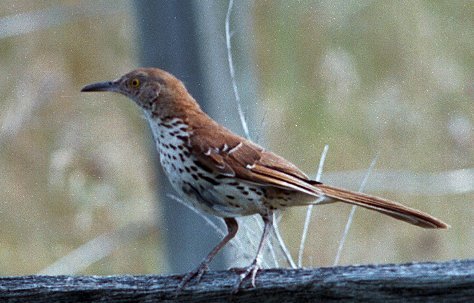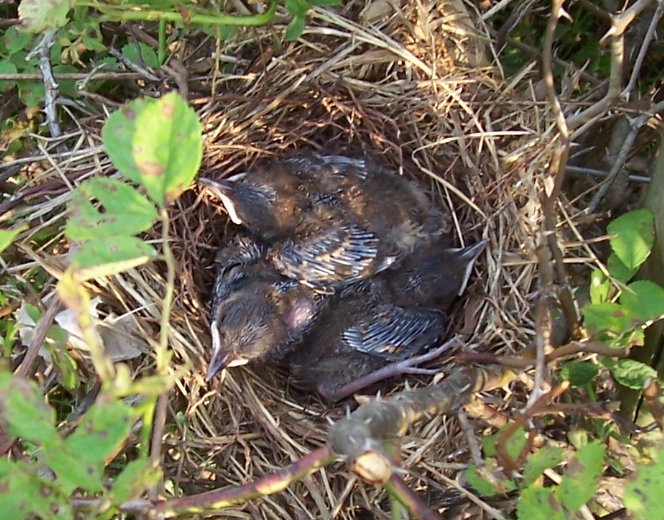Richard and Diane Van Vleck Personal Pages
The Home Habitat |
2005 Nest Cam
Brown Thrasher
Toxostoma rufum

This nesting was the second attempt, after the pair lost their first clutch of eggs to an unknown predator. The nest was built in a volunteer multiflora rose that had sprung up along our property line on the neighbor's fence. It was 30 inches high and in partial sun for much of the day. There was no other tall vegetation adjacent to the rose bush. After the nest was completed and three eggs were laid, I mounted a nest cam above the nest, attaching it to a fence post.
The intense mid-day light proved too much for the sensitive b&w camera, so each morning it was replaced with a much less sensitive color cam and swapped back each evening. The night video was important, in case this second nest was also predated. However, I removed the camera when we were away from home for several days and failed to replace it on our return.
Several days before the nestlings would have fledged, I found two missing and the third dead in the nest with what appeared to be bite marks. The adults were present and still bringing prey to the nest area, but not approaching the nest. One adult perched on the fence rail near the nest, with a moth in its mouth for several minutes before swallowing the moth and flying off. Once again, I didn't follow my own advice of running continuous video to catch such events, even if the tapes are immediately reused when nothing happens. The day that the nest was raided, our neighbor mowed along the fence, within inches of the nest. This may have caused the two nestlings to jump out, making them more at risk of predation. Only the video would have solved this mystery.
 Brown thrashers are known for their ferocious defense of their nests. Examples are often quoted of their attacking humans who approach the nest. This pair were only moderately annoyed when I installed the camera and, later, changed it twice each day and also took still photos of the nestlings. They immediately returned to the nest after my brief visits and never once tried to "attack" me. In fact, only the first time that I approached after the eggs hatched, did they seem unusually upset. That time, the adult on the nest moved back in the safety of cover in the rose bush and made a long drawn out sound between a hiss and a growl. They never made this sound again, but, I can see how it would frighten a predator. The menacing sound certainly didn't resemble any other bird vocalization. On all other visits, they perched nearby on a wooden fence rail or in the mulberry tree and made the usual alarm calls. Unlike their catbird kin, they weren't bothered by my presence until I approached within 5 feet or so of their nest.
Brown thrashers are known for their ferocious defense of their nests. Examples are often quoted of their attacking humans who approach the nest. This pair were only moderately annoyed when I installed the camera and, later, changed it twice each day and also took still photos of the nestlings. They immediately returned to the nest after my brief visits and never once tried to "attack" me. In fact, only the first time that I approached after the eggs hatched, did they seem unusually upset. That time, the adult on the nest moved back in the safety of cover in the rose bush and made a long drawn out sound between a hiss and a growl. They never made this sound again, but, I can see how it would frighten a predator. The menacing sound certainly didn't resemble any other bird vocalization. On all other visits, they perched nearby on a wooden fence rail or in the mulberry tree and made the usual alarm calls. Unlike their catbird kin, they weren't bothered by my presence until I approached within 5 feet or so of their nest.
The early video that I obtained revealed that both sexes share incubation and brooding. In this case, during the hot midday, it was actually shading rather than brooding. The adult would perch in the nest or on the edge and spread its wings enough to shade the nestlings. Neither of the two nest sites this pair selected offered adequate shade. Perhaps, the open view of anything approaching the nest is more important to them. The sparse vegetation of the black raspberry canes and the multiflora rose did provide good camouflage in both cases. I found these nests only by watching the adults from a distance as they brought nesting material.
 As with most species, the thrashers kept the nest quite clean, eating the fecal sacs early on and then flying off with the larger sacs from the older nestlings. I expected to see mostly grubs and caterpillars being brought to the nest, but, they were also bringing many winged insects. Hopefully, the videotape will reveal a fair record of prey items when viewed next winter.
As with most species, the thrashers kept the nest quite clean, eating the fecal sacs early on and then flying off with the larger sacs from the older nestlings. I expected to see mostly grubs and caterpillars being brought to the nest, but, they were also bringing many winged insects. Hopefully, the videotape will reveal a fair record of prey items when viewed next winter.
2012 update - Luckily, the brown thrashers have nested successfully each year since 2005 and are one of our more common species. But, they still seem to occasionally make poor choices of nest sites. On two such occasions, they have built a nest too heavy for the flimsy cane or briar supporting it and the nest has fallen apart before the first egg was laid. But, in both cases, they quickly rebuilt elsewhere.
 The nest location
The nest location
A small multiflora rose along a fence row. Both nest sites this pair chose were in open areas, despite the presence of many thickets of their favored brambles. Note the white pvc cam mount attached to a fence post directly over the nest.
Stills from the videotape
The following still photos are taken from a single frame of video from the vhs tapes. This process results in a substantial loss of quality compared to the original camera image and vhs tape.
three eggs in nest infrared b&w cam
female incubating infrared b&w cam
female incubating infrared b&w cam
female at nest color cam
7/1/2005 eggs color cam
7/1/2005 adult at nest color cam
7/5/2005 female on nest color cam
7/5/2005 female and male at nest color cam
7/5/2005 female with nestling color cam
More info on the brown thrashers nesting on our property will be added in the species account section..
American Artifacts home
email richard@americanartifacts.com
© 2005 - 2010, American Artifacts and Richard Van Vleck, Taneytown, Maryland.
 Brown thrashers are known for their ferocious defense of their nests. Examples are often quoted of their attacking humans who approach the nest. This pair were only moderately annoyed when I installed the camera and, later, changed it twice each day and also took still photos of the nestlings. They immediately returned to the nest after my brief visits and never once tried to "attack" me. In fact, only the first time that I approached after the eggs hatched, did they seem unusually upset. That time, the adult on the nest moved back in the safety of cover in the rose bush and made a long drawn out sound between a hiss and a growl. They never made this sound again, but, I can see how it would frighten a predator. The menacing sound certainly didn't resemble any other bird vocalization. On all other visits, they perched nearby on a wooden fence rail or in the mulberry tree and made the usual alarm calls. Unlike their catbird kin, they weren't bothered by my presence until I approached within 5 feet or so of their nest.
Brown thrashers are known for their ferocious defense of their nests. Examples are often quoted of their attacking humans who approach the nest. This pair were only moderately annoyed when I installed the camera and, later, changed it twice each day and also took still photos of the nestlings. They immediately returned to the nest after my brief visits and never once tried to "attack" me. In fact, only the first time that I approached after the eggs hatched, did they seem unusually upset. That time, the adult on the nest moved back in the safety of cover in the rose bush and made a long drawn out sound between a hiss and a growl. They never made this sound again, but, I can see how it would frighten a predator. The menacing sound certainly didn't resemble any other bird vocalization. On all other visits, they perched nearby on a wooden fence rail or in the mulberry tree and made the usual alarm calls. Unlike their catbird kin, they weren't bothered by my presence until I approached within 5 feet or so of their nest.

 As with most species, the thrashers kept the nest quite clean, eating the fecal sacs early on and then flying off with the larger sacs from the older nestlings. I expected to see mostly grubs and caterpillars being brought to the nest, but, they were also bringing many winged insects. Hopefully, the videotape will reveal a fair record of prey items when viewed next winter.
As with most species, the thrashers kept the nest quite clean, eating the fecal sacs early on and then flying off with the larger sacs from the older nestlings. I expected to see mostly grubs and caterpillars being brought to the nest, but, they were also bringing many winged insects. Hopefully, the videotape will reveal a fair record of prey items when viewed next winter.
 The nest location
The nest location